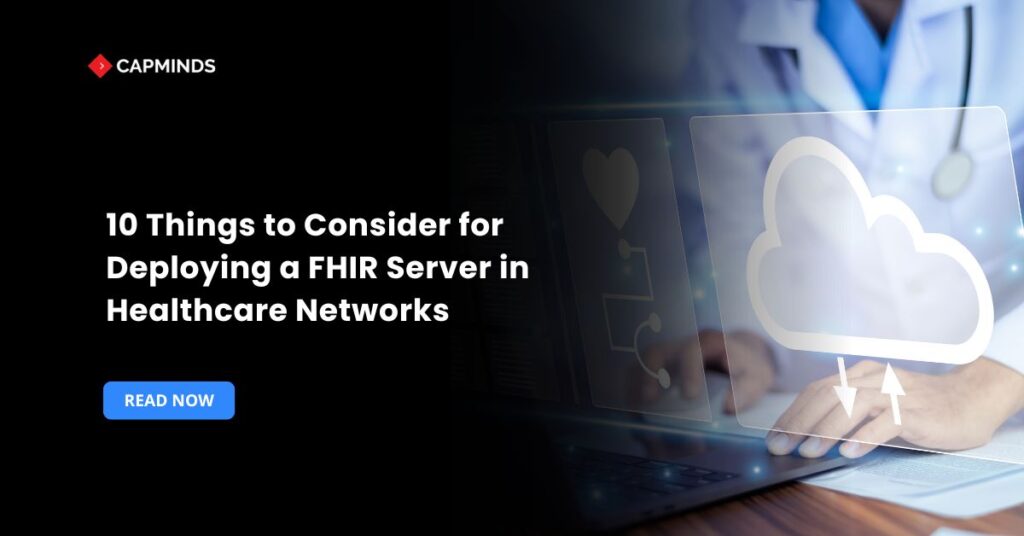10 Things to Consider for Deploying a FHIR Server in Healthcare Networks
Deploying a FHIR server is a crucial step toward enhancing healthcare data sharing. A successful launch requires more than just firing up an instance; it must also handle interoperability, security, performance, governance, and other factors.
In this blog, you’ll learn the 10 essential factors to help guide your FHIR server implementation and ensure it fulfills clinical, operational, and regulatory requirements.
FHIR Server in Healthcare
A FHIR server is a software system that stores, manages, and provides access to healthcare data in a structured format using the FHIR standard.
It facilitates seamless data exchange between different healthcare systems and applications, allowing them to communicate with other healthcare providers and share patient information.
- FHIR server stores healthcare data that includes patient records, medical observations in FHIR format.
- It enables systems to exchange data even if they use different software, providing a common language.
- FHIR servers implement security measures to protect sensitive patient data, ensuring HIPAA compliance.
- FHIR servers can be implemented in various ways, like cloud-based to on-premise systems.
10 Things to Consider Before Implementing a FHIR Server in Healthcare
1. Standard Versioning and Compatibility
- Choose the appropriate FHIR release before deployment. Release 4 is the most mature and normative version, which is suited for production.
- Determine whether your partner systems require prior versions (DSTU2, STU3) and arrange for version translation or simultaneous support.
- Adopt local or national implementation guidelines such as US Core, UK Core.
- Structure Definitions can be used to confine or expand your setting’s defaults.
2. Security and Access Control
- Authentication Mechanisms allow access tokens to be issued and validated using OAuth 2.0 and OpenID Connect. Consider using SMART on FHIR for app-based, patient-centered access.
- Authorization Policies must be implemented, and role-based access control to ensure that only authorized users can read or write certain resource types.
- Implement scopes (e.g., patient/*.read, user/*.write) to granularly limit access.
- Data Encryption allows HTTPS/TLS for any transport. Encrypts data at rest using industry-standard methods (AES-256).
3. Data Model Design and Resource Mapping
- Canonical vs Custom Resources uses the key FHIR resources such as Patient, Observation, and Encounter wherever possible.
- When local processes require custom fields, use Extensions rather than changing core definitions.
- Integrating with a terminology server such as SNOMED CT or LOINC to validate codes and expand value sets. Automate code set changes and version control.
4. Performance and Scalability
Optimize queries for improved performance, scalability, and load balancing. Index commonly requested items like Patient.identifier and Observation.code. Use FHIR search settings wisely and avoid unindexed queries in high-volume processes.
Architect your FHIR cluster for stateless operation, allowing you to add and remove nodes using a load balancer. Use containerization, such as Docker, Kubernetes, to facilitate scalability and orchestration.
Implement HTTP caching (ETags, Last-Modified) to decrease round-trip times. Use an in-memory cache for frequently used resources or terminology searches.
5. High Availability and Disaster Recovery
Deploy numerous FHIR server nodes in different availability zones or data centers. Use database replication with automatic failover for your backend store.
Schedule regular backups of both the database and the settings, like profiles, security policies. Test restore methods every quarter to ensure data integrity and recovery time objectives.
Related: The Ultimate Guide to FHIR Servers (Architecture, APIs, and Best Practices)
6. Audit and Log Events
- FHIR’s AuditEvent captures all create/read/update/delete activities. Log the user’s identity, timestamp, operation type, and resource IDs.
- Logs are sent to a centralized system (ELK stack, Splunk) for real-time monitoring and forensic analysis.
- Set up alarms for unexpected patterns such as massive data exports or repeated failed authentications.
7. Privacy, Consent, and Patient Rights
- Use the FHIR Consent resource to create a model of patient consent. Enforce consent rules in your permission layer, like blocking certain data categories.
- Only reveal the smallest amount of data required for each use case, “minimum necessary” philosophy. Consider using Differential Privacy methods with de-identified data sets.
8. Integration with Existing Systems
- Use an API gateway to combine security, traffic shaping, and request routing for FHIR and older APIs. Create adapters to connect HL7 v2/X12 feeds into FHIR resources as needed.
- Send resource change events via Messaging or Subscriptions to downstream systems (analytics, alerts).
- Real-time updates are supported via REST-based polling as well as WebSocket/Server-Sent Events.
9. Monitoring, Testing, and Validation
- Automate test suites that cover common procedures, including patient registration, lab result retrieval, and document exchange.
- Use FHIR validation tools such as the HL7 FHIR Validator to ensure resource conformity.
- Monitor uptime, average response time, error rates (4xx/5xx), and throughput. Define service-level goals and set alarms when thresholds are exceeded.
10. Governance and Documentation
- Create a cross-functional steering group, such as IT, clinical, and compliance, to manage FHIR projects. Keep a current register of profiles, extensions, and published endpoints.
- Publish clear API documentation (e.g., Swagger/OpenAPI) including examples of queries and answers. Provide training sessions or sandbox environments for application developers and clinical staff.
Related: FHIR, TEFCA & UDS+: How Enterprise-Scale Health Systems Are Gearing Up
A strong FHIR server deployment is more than simply technology; it combines standards alignment, security best practices, operational resilience, and unambiguous governance.
By addressing these 10 factors, healthcare companies can guarantee that their FHIR endpoints provide dependable, secure, and interoperable data sharing, resulting in better patient care and enabling ecosystem innovation.
CapMinds HL7 FHIR Service for Healthcare Practice
CapMinds offers the best all-in-one health interoperability solution for healthcare practices. Our HL7 FHIR service will understand your clinical needs and requirements to cater to our solution.
We have years of experience in this field, faced many challenges, and tackled them with ease. Why can CapMinds be your Go-to Interoperability Solution?
- We are experienced professionals with years of experience in the field.
- Our technical team is an expert that will analyze your healthcare practice thoroughly to tailor the Interoperability solution.
- We prioritize safety, security, encryption, and authentication to protect your healthcare practice’s patient data.
- Our comprehensive solution ensures seamless interoperability, adhering to industry standards and using standard protocols.
- We offer comprehensive training sessions to healthcare staff.
- Our affordable health interoperability solution benefits healthcare practices at all levels.
If you are searching for the best interoperability service for your practice, CapMinds is your choice. We can assist you by navigating all potential challenges and ensuring seamless health data exchange.
Reach out to CapMinds Health Data Exchange Solutions for your Healthcare Practice.




